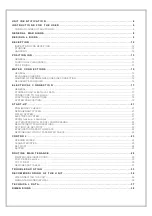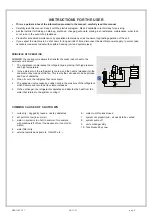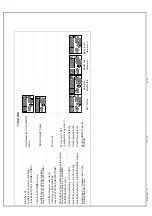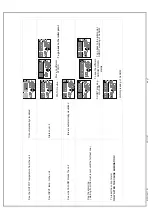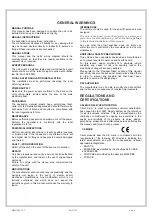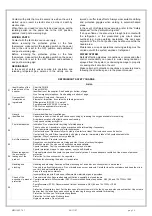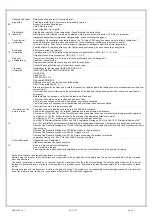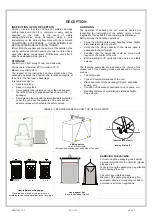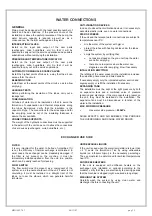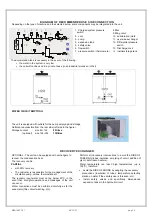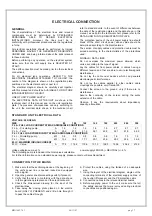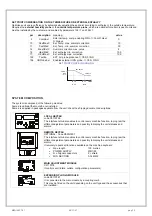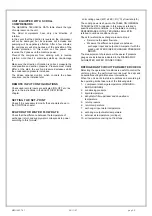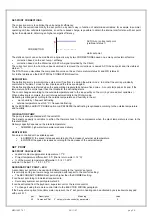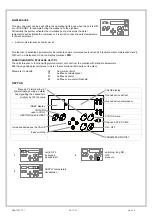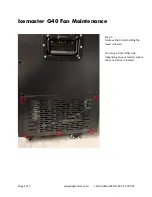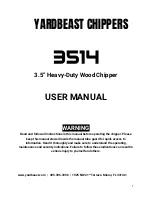
M0G140F7-01 06/11/07
pag
10
Contact with parts that could become live when the unit is
started up can result in electric shock, burns or death by
electrocution.
When there is no need for circuits to be powered up, set the
isolating switch on the power line to the OFF position,
padlock it and post a warning sign.
MOVING PARTS
Contact with the fan rotors can cause injury.
Before removing the protective grilles or the fans
themselves, make certain the isolating switch on the power
line to the unit is set to the OFF position and padlocked,
and post a warning sign.
Before removing the protective grilles or the fans
themselves, make certain the isolating switch on the power
line to the unit is set to the OFF position and padlocked,
and post a warning sign.
REFRIGERANT
In the event of safety valves coming into operation and
releasing refrigerant gas, persons in the vicinity can be
injured or suffer toxic effects. Always wear suitable clothing
and protective goggles when working in potential hazard
areas.
In the event of refrigerant gas escaping, refer to the “Safety
datasheet” for the particular refrigerant.
If an open flame or heat source is brought into contact with
the refrigerant, or the pressurized gas circuit should
overheat (e.g. during welding operations), this can cause
explosion or fire. Do not position any heat source within the
hazard area.
Maintenance or repair operations involving welding must be
carried out with the system emptied of refrigerant.
WATER SYSTEM
Defects affecting pipelines, connections or valves and other
control componentry can result in water being leaked or
sprayed from the system, occasioning damage to property
or causing short circuits in the unit.
Make certain all hydraulic connections are securely made,
following the directions given in the present manual.
REFRIGERANT SAFETY CHARGE
R-410A
01
Identification of the
product and of the
supplier
Chart No FRIG 8
Product R-410A
Identification of the supplier. See heading or bottom of page.
No of emergency telephone. See heading or bottom of page.
02
Composition /
information on
ingredients
Substance/ Compound . Compound
Elements / Impurities. It contains the following elements
Difluorometan (R32) 50 % in weight
Pentafluoroetan (R125) 50 % in weight
CEE No Non applicable for mixtures.
Commercial name /
03
Hazard
identification
Hazard identification. Liquefied gas.
Vapours are heavier than air and can cause choking by reducing the oxygen available for breathing.
A rapid evaporation of the liquid can cause freezing.
It can cause cardiac arrhythmia.
04
First aid measures
Inhalation. Do not administer anything to fainted people.
Take to open air. Administer oxygen or practice artificial breathing if necessary.
Do not administer adrenaline or similar substances.
Contact with eyes. Rinse carefully with plenty of water for at least 15 minutes and consult a doctor.
Contact with the skin. Rinse immediately with plenty of water. Immediately take off all contaminated cloths.
Ingestion. Way of exposure not very probable.
05
Anti-fire measures
Specific hazards. Pressure increase.
Dangerous combustible products. Halogen acids, traces of carbonyl halogens.
Extinction means. You can use all extinction means available.
Special methods. Cool the containers/tanks with sprays of water.
Special protection means. In close spaces, use the self-breather.
06
Measures against
the accidental
leakages of the
product.
Personal protections. Evacuate the personnel in safety areas. Foresee adequate ventilation. Use means of personal
protection.
Protection for the environment. It evaporates.
Methods for eliminating the product. It evaporates.
07
Handling and
stocking.
Handling and stocking. Assure a sufficient exchange of air and/or a suction system in work areas.
Use only in well-ventilated rooms. Do not breathe vapours or aerosols. Carefully close the containers and keep them in a
cool, dry and well-ventilated place.
Keep in the original containers.
Incompatible products. Explosives, inflammable materials, organic peroxides.
08
Check of the
exposition / personal
protection
Personal protection. Assure adequate ventilation, especially in closed rooms.
Control parameters. Difluorometan (R32): Recommended limits of exposition: AEL (8h and 12h TWA) = 1000
ml/m3
Pentafluoroetan (R125): Recommended limits of exposition: AEL (8h and 12h TWA) = 1000
ml/m3
Protection of respiratory tract. For the rescue and for service work in the tanks, use an autonomous breather. Vapours are
heavier than the air and can cause choking by reducing the oxygen available for breathing.
Protection for the eyes. Total protection glasses.
Protection for the hands. Rubber gloves.
Hygienic measures. Do not smoke.



